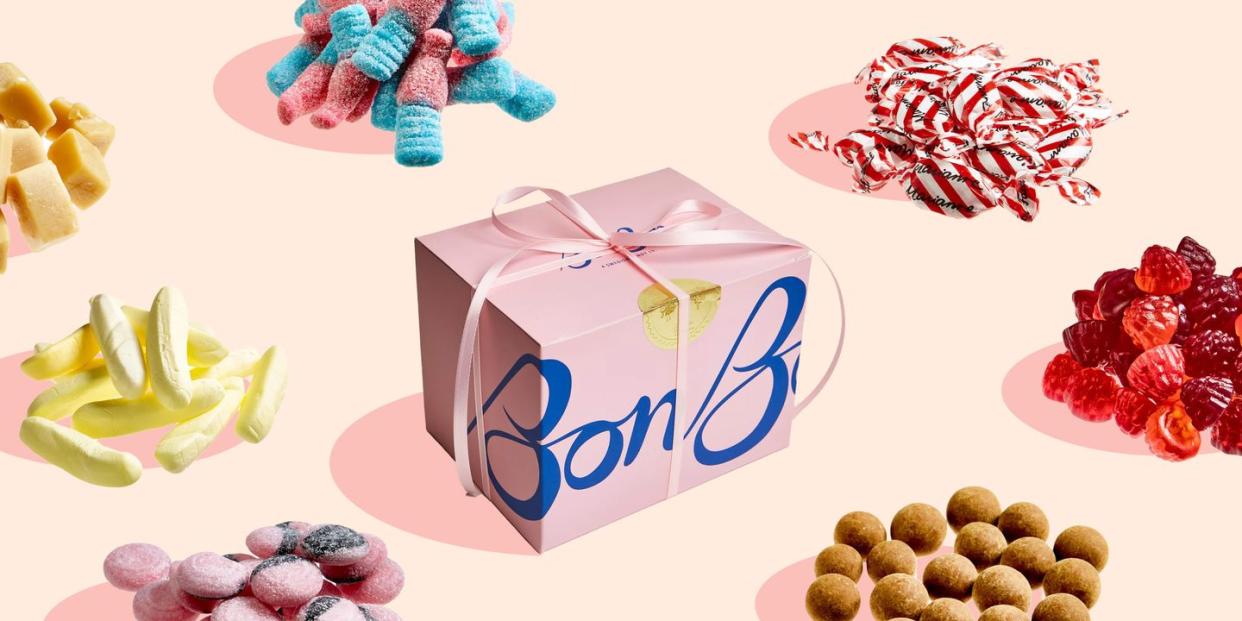Swedish Candy Is Taking Over America And This Store Is Making It Happen

Candy has the unique ability to both unite and divide us. It can garner unwavering loyalty and spark fierce debates—don't even get us started on Red Vines versus Twizzlers. Most importantly, it's at the center of so many traditions: We stuff our stockings with candy canes, we give sweet treats to our Valentines, and we eat our weight in Halloween candy.
American candy culture comes with its own rituals and traditions. But one New York City-based brand is shaking up the sweets scene with Swedish sensibilities. BonBon, founded in 2018 by three Swedes, is bringing imported candy, soda, and snacks to an American audience.
Sweden certainly knows a thing or two about sweets. According to a 2018 study by the Swedish Board of Agriculture, the country's citizens eat nearly 33 pounds per person annually. While candy-centric holidays like Halloween aren't as pervasive as they are in America, enjoying candy regularly has been ingrained into Swedish life for generations.
The Swedish government, after years of ethically questionable medical testing in the mid-20th century, determined that limiting candy consumption to just once a week minimized tooth decay and other health issues. These findings led into a national ritual called lördagsgodis, which translates to "Saturday sweets." Nearly 75 years later you can still find children in Sweden flocking to candy stores every weekend to fill up bags of pick-and-mix candy.
"It was our reward on our day off from school," says Leo Schaltz, one of the founders of BonBon, which now has two brick-and-mortar locations and another on the way. "It's such a big part of Swedish culture."
The design of their store in Williamsburg, Brooklyn, evokes that sensibility with a hearty dose of nostalgia. Framed prints of vintage candy posters feature many of the brands that fill their bulk bins. The candy carts are decorated with whimsical pink and blue striped awnings.
Candy in Scandinavia is also different in terms of its ingredients. With much stricter government regulations on food production in Europe, many of the ingredients in American candies are nowhere to be found in Sweden. The titanium dioxide at the center of a Skittles lawsuit is outright banned in European confections, and American brands are forced to alter their recipes to keep their spots on shelves in the EU. And for Swedish brands, these restrictions are considered a source of pride.
"If you look at the nutrition facts of our candy, you can recognize every ingredient on the list," says Sara Ciliberto, Online Growth Lead at BonBon. "Most Swedish candy is gluten-free, vegan, and has no high-fructose corn syrup." Instead of using gelatin, for example, gummies are made with a mixture of potato and corn starch to achieve their bouncy texture.
The difference in texture and flavor is most obvious when you compare the bright red Swedish Fish with actual Swedish Fish (the ones you know and love are, in fact, made in Canada). The North American version has a tougher, waxier composition with artificial extracts giving it a vaguely fruity flavor. The Swedish-made Pastellfisk (meaning "pastel fish") come in paler hues as a result of the organic dyes and are more tender and almost sticky in texture. Each shade represents their naturally derived flavors—lemon, orange, pear, and berry.
BonBon has even launched a proprietary line of candy fish. Their Sour Wild Strawberry Fish are made in the south of Sweden and will soon be joined by elderflower, blackberry, and peach flavors.
Another version of Swedish fish-shaped candy you won't find in your local supermarket is their licorice variety. In the U.S., black licorice is a divisive treat often skipped over for the strawberry-flavored version. In Sweden, however, it dominates the candy market.
Over 30 different types of black licorice are on display at BonBon in retro-style bulk bins. Many of them fall under the umbrella of salmiak, which pairs the licorice with ammonium chloride for an astringent, salty taste. It's a far cry from the hyper-sweet treats in American candy stores, but Schaltz says there's a growing demand for it.
"There's a secret society of licorice lovers," he says. "People all over the States hunt it down and get super excited that we have such a wide variety." At their Williamsburg location, the BonBon team built a counter specifically to host licorice tastings and convert skeptics.
Regardless if you're a Swedish candy connoisseur or a newbie, the BonBon staff will pull samples from every corner of the store for you to taste. They will help you tailor your own custom bag of pick-and-mix to include some old favorites and undiscovered gems. And while the candy in the bins and the store's decorative touches are distinctly Scandinavian, the nostalgia feels universal. The excitement of choosing the whimsically shaped sweets makes you feel, quite literally, like a kid in a candy store.
Those who can't make it to a BonBon retail locations in New York can still order a curated mix of their candy online. The team even partnered with a Scandinavian designer to create festive Halloween gift boxes so you can celebrate in style.
"It's fun to see everyone get together and share their passion for candy," says Ciliberto. "We're excited to people to experience our brand nationwide."
You Might Also Like

